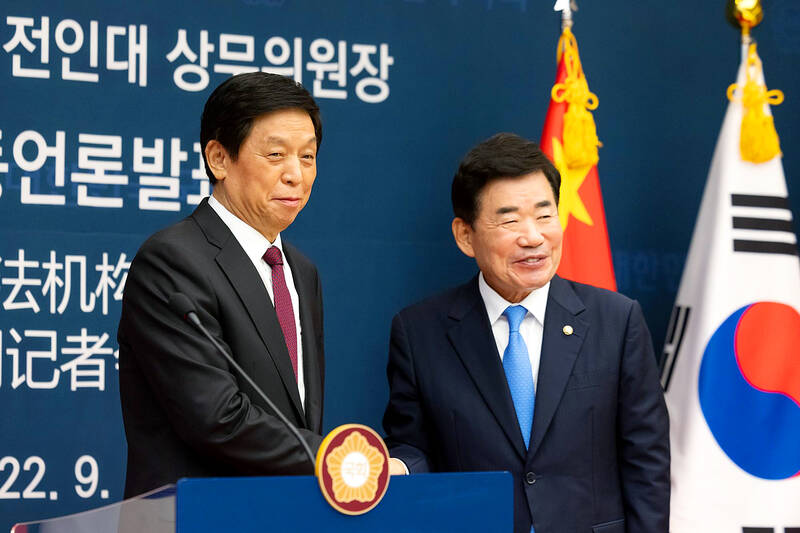China’s top legislator yesterday met South Korean President Yoon Suk-yeol in Seoul, as the two pledged not to let South Korea’s military alliance with Washington become an obstacle to Seoul’s ties with Beijing.
Li Zhanshu (栗戰書), third in the Chinese Communist Party hierarchy and one of Chinese President Xi Jinping’s (習近平) closest confidants, is the highest-level Chinese official to visit South Korea since his predecessor came here in 2015.
Li’s trip is seen as part of Beijing’s efforts to boost ties with neighboring countries ahead of the Chinese Communist Party congress next month that is likely to grant Xi a third five-year term as leader.

Photo: Bloomberg
Li’s visit is also crucial for Yoon’s government as it wants to assure Beijing that its push to reinforce the US alliance and participation in US-led regional initiatives would not target China, its biggest trading partner.
As chairman of the standing committee of the Chinese National People’s Congress, Li is heading a 66-member Chinese delegation to South Korea that includes three Cabinet-level officials.
Li met with Yoon after separate talks with Korean National Assembly Speaker Kim Jin-pyo and other South Korean parliamentary leaders on cooperation between the two countries’ legislatures.
Li’s closeness to Xi suggests his comments reflect the thinking of Xi and his inner circle.
Li said that he does not want a US-made missile shield deployed by Seoul to become “an obstacle to relations” after Beijing slammed its use.
Li agreed with Yoon to continue to “closely communicate” regarding the system known as THAAD, or Terminal High Altitude Area Defense, a statement from the South Korean presidential office said.
Yoon has been trying to balance relations between South Korea’s long-standing US ally and China, his country’s biggest trading partner. The president sent ripples through relations with Washington when he decided against having a face-to-face meeting with US House of Representatives Speaker Nancy Pelosi during her trip to Seoul last month. The snub of the first sitting House speaker to visit the country in about 20 years drew criticism from members of South Korea’s opposition and Yoon’s own conservative party.
Yoon has pledged make the THAAD system fully operational and install another unit in the Seoul area. China objects to the shield over concerns its powerful radar would allow spying on its own missile systems.
Yoon’s office earlier said that he plans to meet US President Joe Biden next week when he travels to New York for a session of the UN General Assembly.
South Korea has shown its displeasure over the Inflation Reduction Act signed last month by Biden, which includes tax credits of as much as US$7,500 for purchases of electric vehicles made in North America. That could disadvantage major South Korean brands such as Hyundai and Kia, which do not have operational EV plants in the US.
Additional reporting by Bloomberg

US President Donald Trump yesterday announced sweeping "reciprocal tariffs" on US trading partners, including a 32 percent tax on goods from Taiwan that is set to take effect on Wednesday. At a Rose Garden event, Trump declared a 10 percent baseline tax on imports from all countries, with the White House saying it would take effect on Saturday. Countries with larger trade surpluses with the US would face higher duties beginning on Wednesday, including Taiwan (32 percent), China (34 percent), Japan (24 percent), South Korea (25 percent), Vietnam (46 percent) and Thailand (36 percent). Canada and Mexico, the two largest US trading

AIR SUPPORT: The Ministry of National Defense thanked the US for the delivery, adding that it was an indicator of the White House’s commitment to the Taiwan Relations Act Deputy Minister of National Defense Po Horng-huei (柏鴻輝) and Representative to the US Alexander Yui on Friday attended a delivery ceremony for the first of Taiwan’s long-awaited 66 F-16C/D Block 70 jets at a Lockheed Martin Corp factory in Greenville, South Carolina. “We are so proud to be the global home of the F-16 and to support Taiwan’s air defense capabilities,” US Representative William Timmons wrote on X, alongside a photograph of Taiwanese and US officials at the event. The F-16C/D Block 70 jets Taiwan ordered have the same capabilities as aircraft that had been upgraded to F-16Vs. The batch of Lockheed Martin

GRIDLOCK: The National Fire Agency’s Special Search and Rescue team is on standby to travel to the countries to help out with the rescue effort A powerful earthquake rocked Myanmar and neighboring Thailand yesterday, killing at least three people in Bangkok and burying dozens when a high-rise building under construction collapsed. Footage shared on social media from Myanmar’s second-largest city showed widespread destruction, raising fears that many were trapped under the rubble or killed. The magnitude 7.7 earthquake, with an epicenter near Mandalay in Myanmar, struck at midday and was followed by a strong magnitude 6.4 aftershock. The extent of death, injury and destruction — especially in Myanmar, which is embroiled in a civil war and where information is tightly controlled at the best of times —

China's military today said it began joint army, navy and rocket force exercises around Taiwan to "serve as a stern warning and powerful deterrent against Taiwanese independence," calling President William Lai (賴清德) a "parasite." The exercises come after Lai called Beijing a "foreign hostile force" last month. More than 10 Chinese military ships approached close to Taiwan's 24 nautical mile (44.4km) contiguous zone this morning and Taiwan sent its own warships to respond, two senior Taiwanese officials said. Taiwan has not yet detected any live fire by the Chinese military so far, one of the officials said. The drills took place after US Secretary